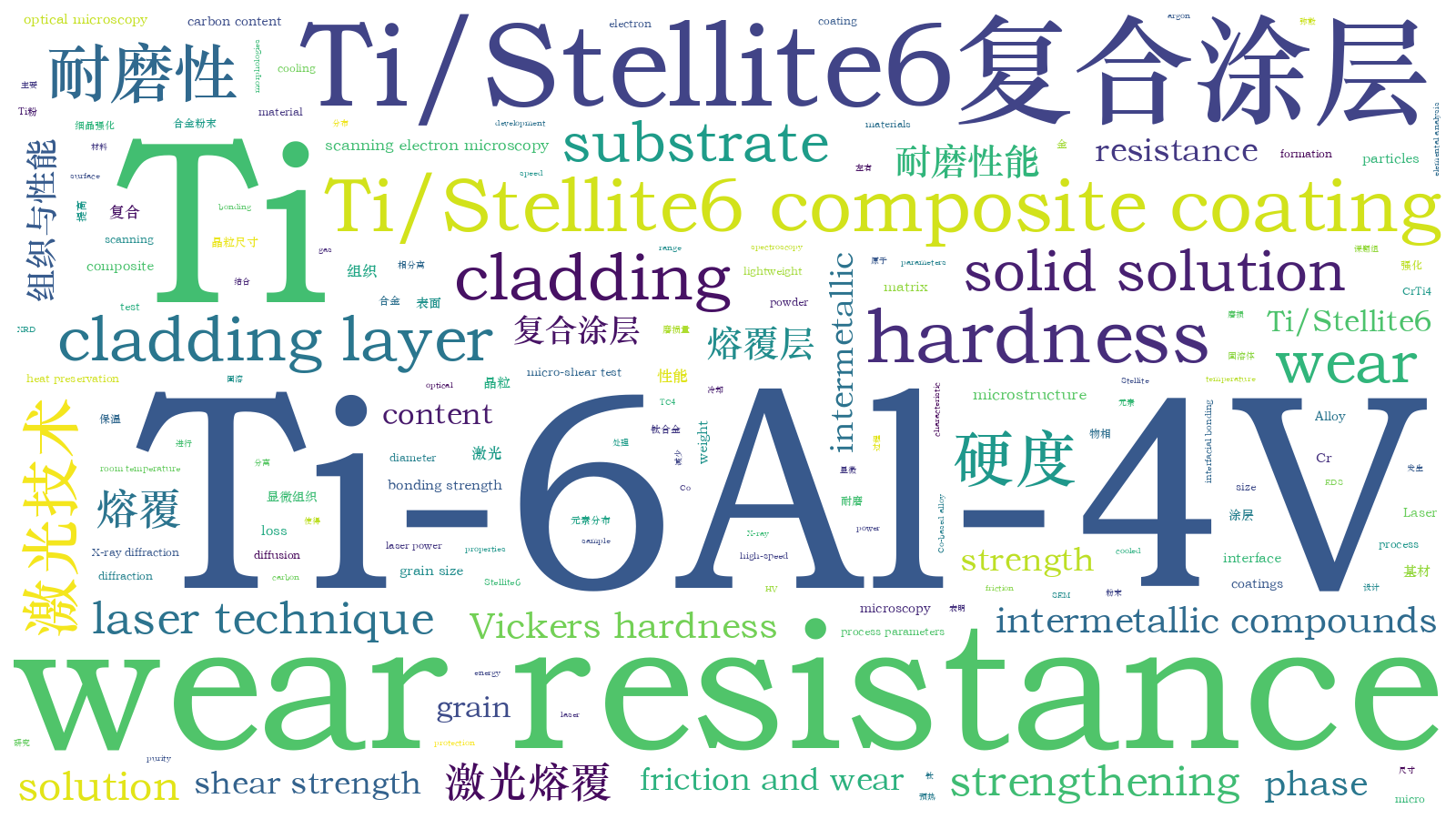Ti-6Al-4V表面激光熔覆Ti/Stellite6复合涂层的组织与性能  下载: 563次
下载: 563次
The development of high-speed train has necessitated the use of lightweight materials. Titanium alloy has the characteristic of high specific strength, which makes it a promising material for reducing the weight of brake discs, but its wear resistance is low. Previous researchers studied wear-resistant coatings by the composite cladding of pure Co and Ti, relying on intermetallic compounds produced by high Co content to improve hardness; however, intermetallic compounds are not conducive for improving the comprehensive properties of coatings. Therefore, this study adopted the better performing Stellite6 alloy, which is a Co-based alloy, and designed a Ti-Co composite alloy with low Co content to improve the hardness and wear resistance of the coating while avoiding the formation of intermetallic compounds.
In this study, Ti-6Al-4V was used as a substrate, and Ti-Co alloy powder (20% Stellite6+ 80% Ti) was used as a cladding material to form the coating. Before cladding, the substrate was cleaned and preheated to 150 ℃. Simultaneously, the alloy powder was evenly mixed then dried at 100 ℃ for 1 h. For cladding, the optimal process parameters (such as laser power and scanning velocity) were used, along with high-purity argon as gas protection. After the cladding was completed, the sample was heat preserved with the substrate for 1 h and then cooled down to room temperature with the substrate. Through X-ray diffraction (XRD), optical microscopy (OM), energy disperse spectroscopy (EDS), scanning electron microscopy (SEM), electron back-scattered diffraction (EBSD), and the Vickers hardness test, the phases, distributions of elements, microstructure morphologies, and hardness were analyzed. The interfacial bonding strength was also measured. Finally, the weight loss was calculated after friction and wear experiments.
The cladding layer has a microstructure characterized by black particles with a size less than 5 μm dispersed in the matrix (Fig. 2). According to the elemental analysis, there are regions in the matrix that are rich in Co but deficient in Cr, and the C element in the dispersed black phase is relatively higher than that in the matrix (Fig. 3). The EBSD phase identification shows that the cladding layer is mainly β-Ti solid solution (Fig. 5) and CrTi4 (Fig. 4), and no intermetallic compounds are formed. Rich Co and less Cr areas are present during the formation of a solid solution. During the heat preservation and cooling process, the β-Ti separation reaction takes place, which implies that the β′ phase, which is the dispersed particles with high carbon content, precipitates. The grain size analysis revealed that 80% of the grains are smaller than 30 μm in diameter, belonging to the fine grain range (Fig. 6). By observing the microstructure of the interface and micro-shear test, it can be seen that the interface is well combined (Fig. 7 and Fig. 8). The interface’s minimum shear strength is 615 MPa, which is significantly higher than the substrate’s shear strength (509 MPa). The average hardness of the cladding layer is 372 HV, which is approximately 80 HV higher than the substrate’s (Fig. 9). The weight loss of the cladding layer is reduced by 38% compared with the substrate (Fig. 10), which implies that the wear resistance is better than that of the substrate. It can be concluded that the abrasive wear occurs according to the grooves of the wear surface (Fig. 11). Results show that the increase in the hardness and wear resistance is mainly due to the solid solution strengthening of generalized β-Ti solid solution, fine grain strengthening, and the diffusion strengthening of the second phase β′.
The composite Ti-Co alloy cladding layer (20% Stellite6+ 80% Ti) is well combined with the Ti-6Al-4V substrate (the micro-shear strength is up to 615 MPa). Because of the low Co content and abundant β stable elements, the main phases of the cladding layer are solid solution β-Ti and CrTi4 without intermetallic compounds. 80% of the grains are smaller than 30 μm in diameter. During the heat preservation and cooling processes, the β-Ti separation reaction takes place, which implies that the β′ phase precipitates as the black dispersed particles. The hardness of the cladding layer is increased by approximately 80 HV, and the wear loss is reduced by 38%. The increase in the hardness and wear resistance is mainly due to the solid solution strengthening of β-Ti solid solution, fine grain strengthening, and the diffusion strengthening of the second phase β′.
钱俊, 胡登文, 陈勇, 陈辉, 刘艳, 杨熊. Ti-6Al-4V表面激光熔覆Ti/Stellite6复合涂层的组织与性能[J]. 中国激光, 2022, 49(11): 1103003. Jun Qian, Dengwen Hu, Yong Chen, Hui Chen, Yan Liu, Xiong Yang. Microstructure and Properties of Laser Cladded Ti/Stellite6 Composite Alloy Coating on Ti-6Al-4V Substrate[J]. Chinese Journal of Lasers, 2022, 49(11): 1103003.







